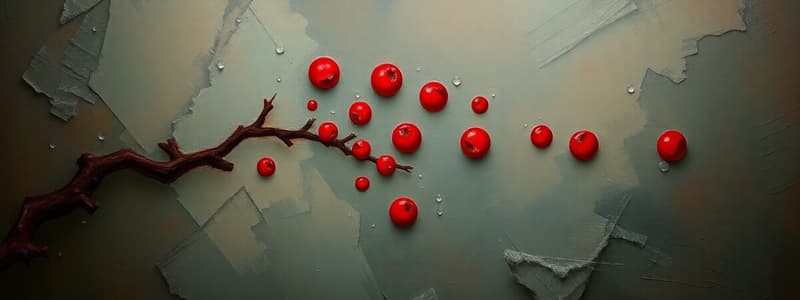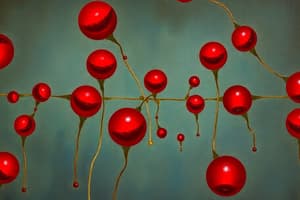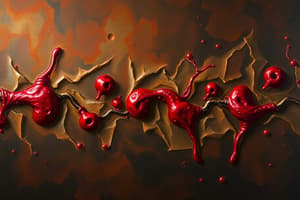Podcast
Questions and Answers
Quale substanzia activa la via intrinseca de coagulation?
Quale substanzia activa la via intrinseca de coagulation?
- Fibrinogen
- Vitamin K
- Tissue factor (III)
- Collagen exposte (correct)
Quale factor de coagulation es necessita pro activation del factor 10?
Quale factor de coagulation es necessita pro activation del factor 10?
- Prothrombin (II)
- Factor 5 (correct)
- Factor 8
- Factor 13
Quale effecto ha thrombin (IIa) in le cascada de coagulation?
Quale effecto ha thrombin (IIa) in le cascada de coagulation?
- Conversion de fibrinogen in fibrin
- Negative feedback
- Profound positive feedback (correct)
- Inhibition de platelets
Quale factor es assente in le hemophilia menos commun?
Quale factor es assente in le hemophilia menos commun?
Quale organo es responsabile pro production de factores de coagulation?
Quale organo es responsabile pro production de factores de coagulation?
Flashcards
Via intrinsice del coagulation
Via intrinsice del coagulation
Li via que comensa con le contacto de collageno exponete, resultante in le activation de plus factores de coagulation.
Factor XII (12)
Factor XII (12)
Un factor critic in le via intrinsice del coagulation, activate per contacto con collageno exponete.
Thrombin (IIa)
Thrombin (IIa)
Un enzyma potente que catalysa le conversion de prothrombin a thrombin.
Via extrinsece del coagulation
Via extrinsece del coagulation
Signup and view all the flashcards
Prothrombin (II)
Prothrombin (II)
Signup and view all the flashcards
Study Notes
Clotting Cascade
-
The intrinsic pathway begins with vessel damage, exposing collagen, initiating a cascade of reactions.
-
The extrinsic pathway begins with subendothelial cells or tissue damage, activating a separate cascade.
-
Exposed collagen triggers factor XII activation.
-
Factor XIIa activates factor XI, which then activates factor IX.
-
Factor IXa, with its cofactor, activates factor X.
-
Factor Xa, with its cofactor, converts prothrombin to thrombin.
-
Thrombin converts fibrinogen to fibrin, forming a clot.
-
Platelets are activated by thrombin and exposed collagen, contributing to clot formation.
-
The extrinsic pathway involves tissue factor (factor III), which activates factor VII.
-
Factor VIIa activates factor X, leading to thrombin formation and clot formation, similarly to the intrinsic pathway.
-
The liver produces clotting factors, requiring vitamin K.
-
Cofactors (e.g., phospholipid) enhance the efficiency of the clotting factors.
-
A positive feedback loop amplifies the clotting cascade.
Studying That Suits You
Use AI to generate personalized quizzes and flashcards to suit your learning preferences.




